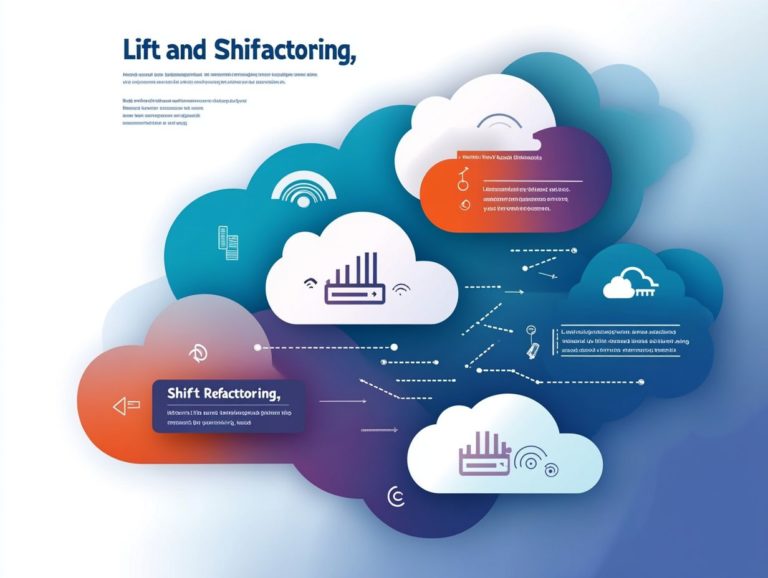Hybrid Cloud Management Tools You Should Consider
In today s fast-paced digital landscape, many businesses are increasingly embracing hybrid cloud solutions to enhance their operations. However, navigating this complex environment can feel overwhelming at times.
This guide delves into hybrid cloud management tools, highlighting their benefits, essential features, and the leading options available to you. It also includes real-world case studies, addresses common challenges, and offers best practices to help you select the right tool for your specific needs.
Get ready to supercharge your hybrid cloud strategy now!
Contents
- Key Takeaways:
- 1. Hybrid Cloud Management Tools Overview
- 2. Benefits of Using Hybrid Cloud Management Tools
- 3. Key Features to Look for in Hybrid Cloud Management Tools
- 4. Top 5 Hybrid Cloud Management Tools
- 5. Comparison of Features and Pricing
- 6. Case Studies of Companies Using Hybrid Cloud Management Tools
- 7. Common Challenges and How Hybrid Cloud Management Tools Can Help
- 8. Best Practices for Implementing and Managing Hybrid Cloud Management Tools
- 9. Future Trends in Hybrid Cloud Management Tools
- 10. How to Choose the Right Hybrid Cloud Management Tool for Your Business
- 11. Integration with Other Cloud Management Tools
- 12. Security and Compliance Considerations
- 13. Support and Training Options
- 14. Customer Reviews and Ratings
- Frequently Asked Questions
- Qu son las herramientas de gesti n de nube h brida?
- Por qu deber a considerar usar herramientas de gesti n de nube h brida?
- Qu caracter sticas deber a buscar en las herramientas de gesti n de nube h brida?
- Cu les son algunas herramientas populares de gesti n de nube h brida?
- Las herramientas de gesti n de nube h brida funcionan con todos los tipos de nubes?
- C mo puedo justificar el costo de invertir en herramientas de gesti n de nube h brida?
Key Takeaways:

Hybrid cloud management tools can increase efficiency and flexibility for businesses by integrating public and private cloud environments.
Key features to consider are automation, scalability, and cost optimization. When choosing a hybrid cloud management tool, consider integration capabilities, security and compliance measures, support and training options, and customer reviews.
1. Hybrid Cloud Management Tools Overview
Hybrid cloud management tools are critical as you navigate the intricacies of handling multiple cloud environments. Exploring the top hybrid cloud tools and technologies can enable seamless integration and optimize resources while ensuring compliance with security standards.
By leveraging these tools, you can enhance operational efficiency and streamline data integration processes. This helps establish a more cohesive infrastructure management strategy.
Embracing a hybrid architecture gives you the power to tap into the advantages of various cloud providers, helping your business adapt to new technologies while maintaining centralized control over your resources.
Tools like Apache CloudStack and Microsoft Azure Arc provide robust solutions that enable your IT teams to oversee workloads across on-premises and cloud platforms with ease.
For instance, Apache CloudStack automates resource deployment, allowing you to maximize your investments and minimize downtime. Meanwhile, Microsoft Azure Arc extends Azure services to any infrastructure, enhancing governance and compliance across diverse environments.
By integrating these tools into your operations, you can achieve improved resource allocation and maintain data integrity. You will also adhere to regulatory requirements all vital elements for driving a successful digital transformation strategy.
2. Benefits of Using Hybrid Cloud Management Tools
Utilizing hybrid cloud management tools presents you with a wealth of advantages. These include enhanced resource optimization, improved cost management, and scalability features that seamlessly adapt to your business needs.
These tools reveal significant cost-saving opportunities by enabling you to allocate resources more efficiently. This minimizes waste along the way.
With enhanced scalability at your fingertips, your business can swiftly respond to fluctuating workloads without incurring unnecessary expenses. Performance monitoring is also notably improved, providing you with real-time insights.
These insights empower your teams to make informed decisions. Automation tools streamline your processes, while strict adherence to compliance standards helps you effectively manage risks.
This intelligent integration not only safeguards your data but also enhances your agility and responsiveness to ever-changing market demands.
3. Key Features to Look for in Hybrid Cloud Management Tools
When you re selecting hybrid cloud management tools, it s essential to weigh key features like automation capabilities and scalability options. These elements are critical for effectively managing workloads across diverse cloud environments.
Consider how these attributes can help you optimize your cloud operations. For example, tools like Google Anthos offer automation capabilities. This enables your teams to deploy applications consistently across different platforms, minimizing the risk of manual errors.
Performance tracking features provide you with real-time insights into system health. This allows you to respond swiftly to any issues that may arise.
Scalability options in solutions such as Red Hat OpenShift give you the power to adjust resources seamlessly based on demand. This feature lets you swiftly manage workload changes, keeping your operations running smoothly.
API compatibility is crucial. It enables the seamless integration of various services, allowing for centralized control and optimizing resource scheduling an essential aspect for maintaining data synchronization across all your environments.
4. Top 5 Hybrid Cloud Management Tools
The top five hybrid cloud management tools Apache CloudStack, Cisco Intersight, and IBM Cloud Satellite offer innovative solutions for navigating diverse cloud environments while optimizing resources and ensuring compliance.
These tools provide seamless integration capabilities tailored to your business needs. This makes it easier for you to manage workloads across both on-premises and public cloud systems.
Take Apache CloudStack, for instance: its open-source architecture allows you to deploy and manage extensive networks of virtual machines. This gives you the flexibility you desire.
Cisco Intersight brings powerful analytics and automation features to the table. This enhances operational efficiency, especially if you re already leveraging Cisco infrastructure.
On the other hand, IBM Cloud Satellite gives you the power to securely extend your cloud services across multiple environments. This makes it an ideal choice for enterprises focused on scalability and compliance.
These tools will boost your hybrid cloud strategy and make managing your complex architectures easier than ever.
5. Comparison of Features and Pricing

A comprehensive comparison of features and pricing among leading hybrid cloud management platforms enables you to make informed decisions tailored to your specific needs and budget. This ensures optimal performance monitoring and scalability.
By examining the unique characteristics of various tools, you can gain a clearer understanding of how they align with your operational objectives. This is especially important in terms of cost management and user experience.
This analysis requires a careful evaluation of critical aspects, such as pricing tiers and ease of integration. For instance, some platforms may excel in robust cost analytics, while others might focus on offering an intuitive interface that fosters user engagement.
Identifying the strengths and weaknesses of each option gives you the power to select a solution that not only meets your current requirements but also scales efficiently as your operations expand.
6. Case Studies of Companies Using Hybrid Cloud Management Tools
Examining case studies shows how companies effectively used hybrid cloud management tools and reveals the profound impact on their operations. This is particularly evident in terms of cost management and enhanced digital transformation initiatives.
Consider a prominent retail firm that struggled with fluctuating customer demand and inconsistent resource allocation. By adopting hybrid cloud management solutions, this organization maintained optimal performance during peak shopping seasons while simultaneously minimizing costs during slower periods.
Next, a tech startup faced obstacles with performance tracking. They turned to these management tools for real-time insights into their cloud environments. The results were remarkable: not only did they improve system uptime, but they also accelerated their development speed, achieving a notable 40% reduction in deployment times and a significant boost in overall productivity.
7. Common Challenges and How Hybrid Cloud Management Tools Can Help
You may encounter several common challenges when managing hybrid cloud environments, such as resource scheduling, data integration, and compliance management. Fortunately, hybrid cloud management tools can effectively tackle these issues.
A primary struggle you might face is data silos that obstruct seamless access to critical information across different platforms. Navigating compliance risks from different regulations complicates data security efforts.
Tools like CData Sync enable you to streamline data integration, allowing for real-time access and collaboration across multiple systems. Meanwhile, Oracle Cloud Infrastructure enhances resource portability, making it easier for you to move workloads while maintaining stringent compliance measures.
Together, these solutions simplify management and empower you to respond swiftly to evolving business needs, fostering innovation and growth.
8. Best Practices for Implementing and Managing Hybrid Cloud Management Tools
Implementing hybrid cloud management tools effectively requires adherence to best practices. Establish governance policies, ensure compliance with rules your business must follow to keep data safe, and use automated tools to streamline your infrastructure management.
To unlock the benefits of these tools, invest in comprehensive training for your staff on compliance rules and the effective use of automation tools. This training equips your team with necessary skills and fosters a culture of accountability, which is vital for maintaining compliance across various operations.
Integrating these practices boosts your operational efficiency and reduces errors. Regular reviews and updates of these systems are crucial to ensure they align with evolving industry standards and technologies, helping you sustain a competitive edge.
9. Future Trends in Hybrid Cloud Management Tools
Exciting trends are shaping the future of hybrid cloud management tools! Enhanced automation capabilities, AI-powered analytics, and seamless cloud integration are all designed to elevate your operational efficiency and scalability.
As your organization increasingly leans on hybrid cloud environments, integrating AI and machine learning is poised to transform resource management. Imagine having real-time insights that dynamically adjust workloads based on demand, making your operations smarter and more responsive.
Predictive analytics will become essential for you, giving your teams the power to anticipate potential issues before they spiral out of control. This proactive approach optimizes performance and minimizes downtime.
The blend of these advanced technologies isn t merely about automating tasks; it significantly enhances your user experience, making interactions with cloud interfaces more intuitive and streamlined. Ultimately, this fosters a culture of innovation and agility within your business.
10. How to Choose the Right Hybrid Cloud Management Tool for Your Business

Choosing the right hybrid cloud management tool for your business requires careful evaluation of your specific needs. Consider scalability features, cost management options, and the overall user experience to ensure seamless cloud integration.
This process demands a thorough understanding of your organization s unique priorities and the various functionalities these tools provide. Determine how well these features align with your strategic goals, whether that means improving operational efficiency or boosting cooperation across teams.
Assessing the long-term scalability of the solutions is key to understanding their ability to adapt as your business evolves. Additionally, keep a close eye on cost implications; the right choice can lead to significant savings while still delivering the necessary capabilities to support a dynamic and flexible IT infrastructure.
11. Integration with Other Cloud Management Tools
Effective integration with other cloud management tools is vital for optimizing your hybrid cloud strategy. This ensures connection compatibility, seamless data synchronization, and efficient automation management.
When your tools boast robust integration capabilities, you can easily connect your on-premises resources with public clouds. This creates a fluid exchange of data and processes between different environments.
For example, a hybrid cloud management tool that syncs with platforms like AWS or Azure can provide real-time monitoring and analytics, empowering your teams to quickly identify inefficiencies.
Such integration simplifies the management of multiple systems, promoting streamlined workflows and enhancing user collaboration. Ultimately, this cohesive environment boosts your operational agility and drives significant cost savings, making it a crucial consideration for any organization looking to harness the potential of their cloud ecosystems.
12. Security and Compliance Considerations
Security and compliance are absolutely vital when managing hybrid cloud environments. You need to implement robust data protection measures, establish stringent user access controls, and ensure adherence to governance policies.
As you navigate the complexities of integrating on-premises and cloud-based systems, you’ll encounter unique challenges, such as ensuring data integrity and mitigating risks from unauthorized access.
The ever-evolving regulatory landscape demands your vigilance, compelling you to stay updated on compliance obligations specific to your industry.
To effectively address these concerns, leveraging cloud access security brokers (CASBs) and robust encryption tools is essential. By implementing continuous monitoring and auditing, you can detect any irregularities.
Train your employees on security best practices to foster a culture of compliance within your organization.
13. Support and Training Options
Comprehensive support and training options are essential for organizations utilizing hybrid cloud management tools. They enhance the user experience and ensure optimal operational efficiency across various cloud environments.
These resources empower you to navigate complex integrations with ease, streamline processes, and make informed decisions. A mix of on-demand webinars, interactive tutorials, and hands-on workshops can significantly elevate your understanding, enabling your team to adapt swiftly to new features and updates.
Ongoing education is crucial; it sharpens your skills while keeping you informed about best practices and emerging trends in cloud strategy. Exceptional customer support services play a key role in addressing your queries and resolving challenges promptly, ultimately maximizing the value your organization gains from its chosen platforms.
14. Customer Reviews and Ratings
Customer reviews and ratings offer invaluable insights into the effectiveness and user experience of various hybrid cloud management platforms, guiding your selection process.
These evaluations often shed light on critical factors that can influence your decision-making, such as overall user satisfaction, software performance, and the intuitiveness of the interfaces.
As you transition to hybrid cloud environments, grasping the strengths and weaknesses noted by other users becomes essential. Trends in user feedback can reveal common pain points and favored features, helping you identify emerging leaders in the market.
Consistent high ratings may indicate reliable performance and exceptional customer support. On the other hand, declining scores can highlight areas that need improvement, ultimately shaping future innovations in cloud management solutions.
Frequently Asked Questions

Qu son las herramientas de gesti n de nube h brida?
Las herramientas de gesti n de nube h brida son soluciones de software que ayudan a las organizaciones a gestionar y optimizar su infraestructura de nube h brida. Estas herramientas ofrecen funciones como monitoreo, automatizaci n y gesti n de costos para simplificar la gesti n de entornos de nube tanto p blicos como privados.
Por qu deber a considerar usar herramientas de gesti n de nube h brida?
Las herramientas de gesti n de nube h brida mejoran la eficiencia y reducen costos.
Proporcionan una vista completa de su entorno de nube h brida.
Qu caracter sticas deber a buscar en las herramientas de gesti n de nube h brida?
Busque caracter sticas como monitoreo centralizado y colocaci n autom tica de cargas de trabajo.
Tambi n considere la optimizaci n de costos y la gobernanza basada en pol ticas.
Cu les son algunas herramientas populares de gesti n de nube h brida?
Algunas herramientas populares incluyen VMware Cloud Foundation y Microsoft Azure Stack.
Eval e sus necesidades y elija la herramienta que mejor se adapte a sus requisitos.
Las herramientas de gesti n de nube h brida funcionan con todos los tipos de nubes?
La mayor a de las herramientas funcionan con nubes p blicas, privadas e h bridas.
Verifique la compatibilidad con su infraestructura antes de decidir.
C mo puedo justificar el costo de invertir en herramientas de gesti n de nube h brida?
Invertir en estas herramientas puede generar ahorros a largo plazo.
Optimizan el uso de recursos y reducen el tiempo de inactividad.






